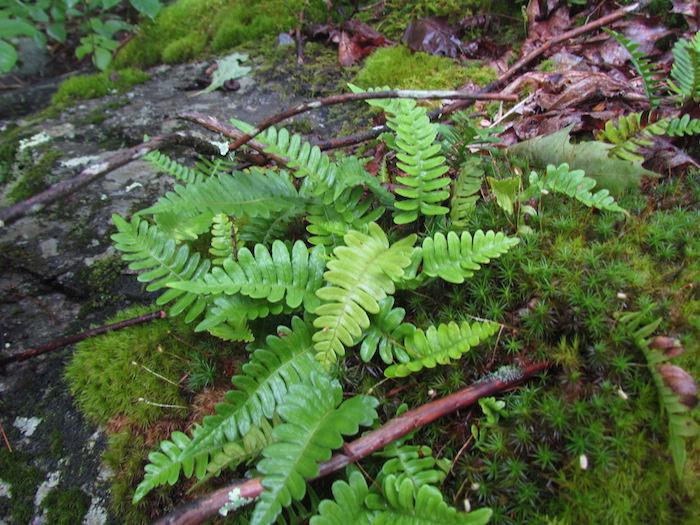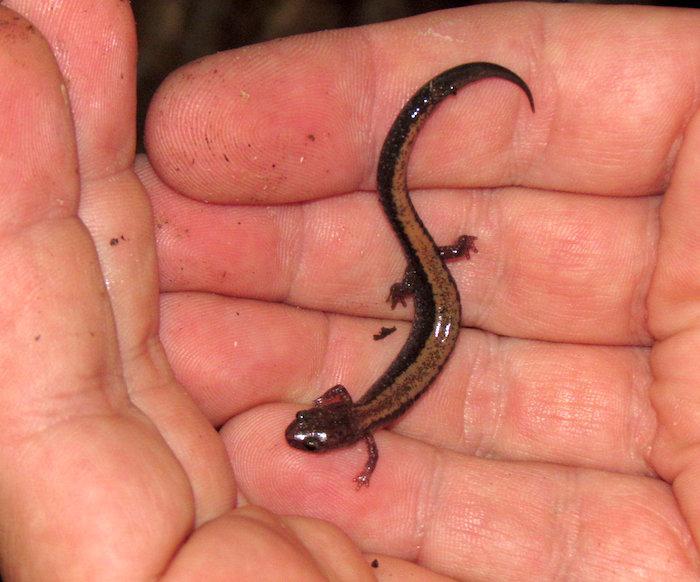
Fall is a good time to spot bears in Shenandoah National Park, not so much birds/Kirby Adams
There are good times to go birding in Eastern forests and times that are less than ideal. I won’t say the birding is ever “bad,” because even if there aren’t any birds, a walk in the woods is never a bad thing. Still, if seeing tons of birds and hearing beautiful songs is on your agenda, avoid August. Head to the beaches to see shorebird migration.
If being in the woods is enough reward in itself, take a stroll in Shenandoah National Park in Virginia. The scenery never disappoints, the flora is fascinating, there are endemic salamanders on talus slopes, and you’ll probably see a bear. And on a drizzly weekday morning, you might even see some good birds on the descent to Dark Hollow Falls.
The Dark Hollow Falls Trail is the most popular hike in the park, with a short but steep descent to a secluded waterfall. The trailhead is almost literally across the street from the Big Meadows complex of visitor amenities. If the weather is good or it’s a weekend, you’ll see a waterfall and lots of people. Go early on a weekday morning with a light rain falling and you’ll see more of what Shenandoah is all about.
There are bears all over the park, and a walk on a trail that hasn’t had much foot traffic in the last hour or so is a good way to see one. I have a tendency to be looking up with binoculars (birds) or looking at the ground with a camera (ferns), so the bears usually see me long before I see them. That’s usually a good thing. When I’m precariously leaning against a boulder to photograph some Polypody ferns (a species that specializes in growing on granite) one of the things I don’t really want to hear from my partner up on the trail is, “There’s a bear.” A somewhat worse follow-up is, “It’s a really little one.” That incident ended well, despite my needing to stumble back to the trail within ten yards of a young black bear having breakfast in a raspberry thicket. There was likely a more perturbed and much larger bear in the vicinity, but thankfully she didn’t make an appearance, and I tipped my cap to the invisible mama in thanks.

Polypody ferns stand out on drizzly days in Shenandoah/Kirby Adams
That story is reminiscent of the time I was looking at a Yellow-breasted Chat through binoculars and almost walked into a bedded bison in Theodore Roosevelt National Park in North Dakota. The moral of these tales is to remain aware of your surroundings, even when the birding and botanizing compete to steal your attention. I’ve always remembered this in Saguaro National Park in Arizona where walking without watching your feet can result in an unpleasant introduction to one of a half-dozen species of rattlesnake. For some reason, as I move east I become too complacent.
Back in Shenandoah, there are still birds in the woods in August. Wood Thrushes zip through the understory making a smacking chip call. Their distinctive song, a haunting but energetic “EE-oh-LAYYY” as if played by an alien woodwind, is left to June and July. In August they rarely sing and you need to pause when you hear the chips and wait for the thrushes to show themselves as they burst off the ground for a quick relocation.
Warblers that are only transient migrants in the lower elevations are wrapping up their nesting season in the mountains. As with the thrushes, you probably won’t hear much singing. Faint chips or a movement in a tree are the only clues. If you see a warbler foraging, stop and watch the area. They forage where there are good bugs or berries, and a good foraging tree will attract multiple birds. Several species of warbler in a single tree aren’t unusual late in the season when nesting territories are no longer of concern to the birds.

Red Backed salamanders are common in Shenandoah/Kirby Adams
From some of the higher slopes, the majesty of the Shenandoah Valley opens beneath you. It’s also where you’ll catch sight of hawks and vultures. As a well-rounded naturalist, you may miss a good hawk because you’re checking the ground for a true rarity – the Shenandoah Salamander. This tiny amphibian lives in only three spots on Earth, all of them talus slopes in Shenandoah National Park. It looks similar to the closely related Red Backed Salamander. On several trips to Shenandoah, I’ve found scores of Red Backed, but have never managed a Shenandoah. That highlights a difference between my herping (looking for reptiles and amphibians) and birding habits. I’ll look for salamanders for a while, but it’s a rather invasive practice – certainly more stressful to the animal than birding is to birds, at least when done properly. I usually quit looking for salamanders after a while and feel satisfied just knowing that they’re out there.
Shenandoah is a fabulous park any time of year, but there’s something peaceful about late summer. The outburst of flora in the spring is long past, and the onslaught of visitors for fall foliage is still weeks away. For now, all there is to do is stand a couple thousand feet above the valley floor with an Indigo Bunting serenading the scene.



Add comment